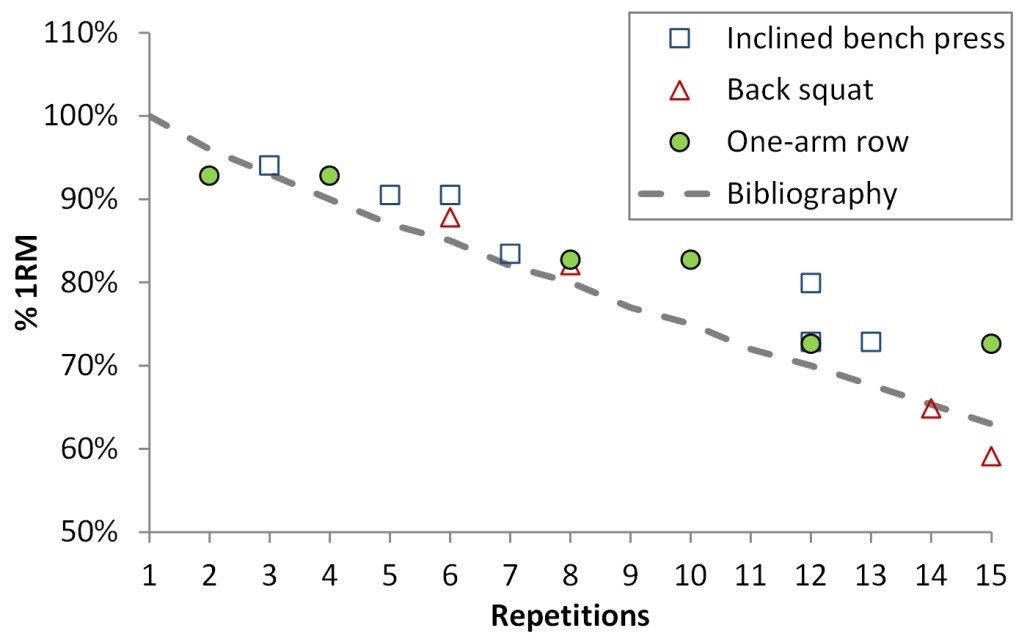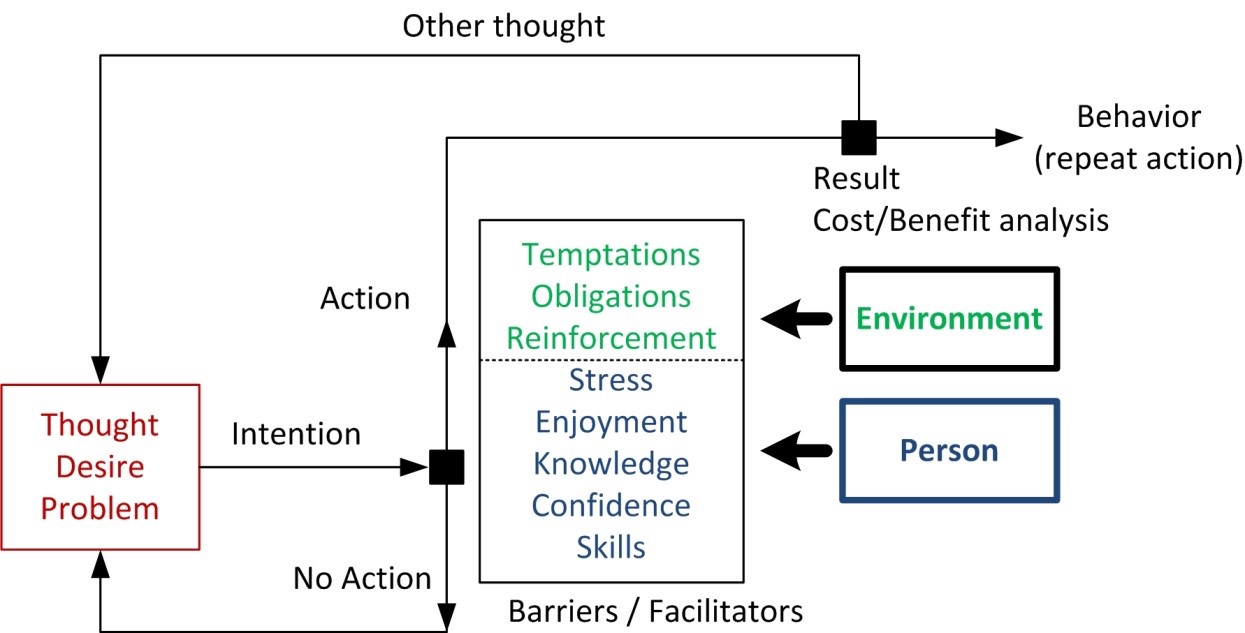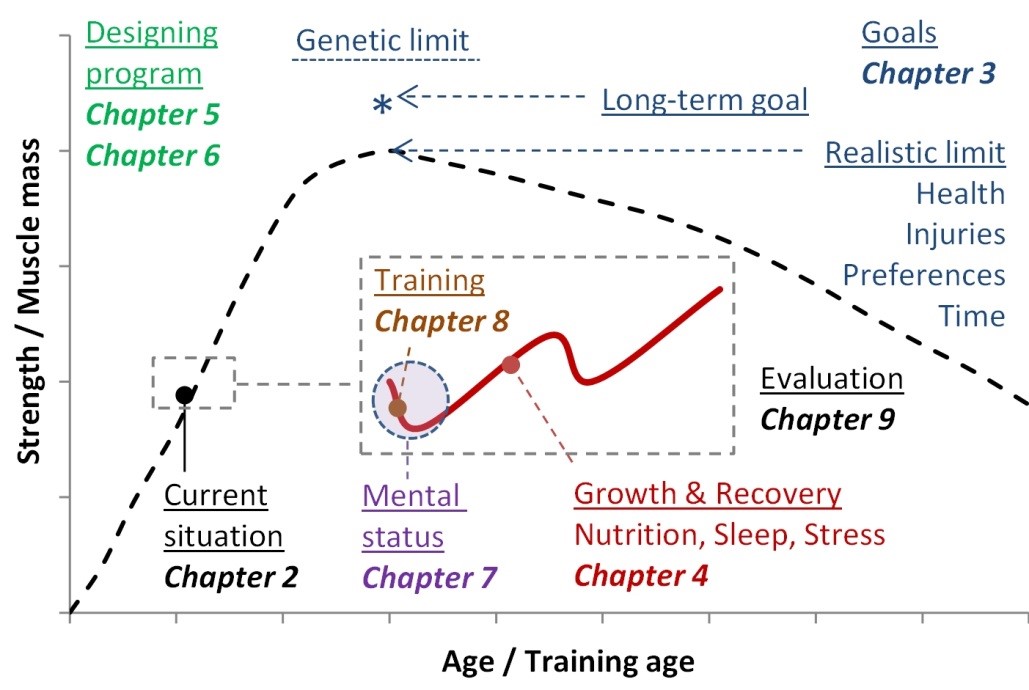1. Weight Training Procedure
This chapter will present some basic definitions and a weight training procedure that can maximize the desired results. In the following chapters, “he” or “his” are used with a gender-neutral meaning unless specified otherwise (e.g., during discussion about men-women differences, and specific goals for men and women).
Definitions
A repetition is a single complete movement of an exercise. It normally consists of two phases: the concentric muscle action, where muscles contract (usually during lifting the weight), and the eccentric muscle action, where muscles are lengthened (usually during lowering the weight). The weight that is used is called resistance (in the literature also referred to as load). The ratio of the weight to the maximum weight that can be lifted for one repetition is called intensity of resistance.
Note: In this book the term load refers to the workout stimulus and thus includes the exercises and repetitions, but also the duration of the training, the rest periods, etc. Thus, load will be used only during the discussion of training principles (overload principle).
A set is a group of repetitions performed continuously without stopping or resting, typically from 1 to 15 repetitions.
The term volume refers to a measure of the total amount of work (in joules) performed in a period of time (usually training session or week). Repetition work is the resistance (weight) multiplied by the vertical distance the weight is lifted. To calculate the workout work, the number of repetitions per set and the total sets have to be considered. Simpler definitions for volume have been used in the literature: For example, “sets”, “sets × reps”, or “sets × repetitions × resistance”. In this book the term training volume refers to the last case (sets × repetitions × resistance), unless otherwise specified.
A repetition maximum, or RM, is the maximal number of repetitions of a set that can be performed in succession with proper lifting technique using a given weight (resistance) (Fleck and Kraemer 2014). The heaviest resistance (weight) that can be used for one complete repetition of an exercise is called 1RM. A resistance that allows completion of 10, but not 11, repetitions with proper exercise technique is called 10RM. Note that, strictly speaking, this is a self-determined repetition maximum, as the trainee’s prediction that he will not be able to complete one more repetition, is not necessarily true.
Momentary concentric muscular failure is reached when one reaches the point where he cannot complete the concentric portion of the current repetition without deviation from the prescribed form of the exercise, despite attempting to do so (Steele et al. 2017). Thus, for the above example, training to true momentary failure would mean trying (and failing) the 11th repetition. Training to failure is sometimes assumed as training with intensity of effort of 100% or having 0 repetitions in reserve or reaching rating of perceived exertion of 10 (Zourdos et al. 2016) (Table 1.1).
Table 1.1: Training to momentary muscular failure, rating of perceived exertion (RPE), repetitions in reserve (RIR), and intensity of effort. Training to repetition maximum (RM) is equivalent to RIR of 0. Adapted from Zourdos et al. (2016).
| RPE | RIP | Effort | Comments |
|---|---|---|---|
| 10 | 0 | 100% | The last rep could not be completed. Momentary muscular failure. |
| 9.5 | 0 | 95% | The last rep could be completed, but another one is not possible. |
| 9 | 1 | 90% | One more rep could be completed. |
| 8 | 2 | 80% | Two more reps could be completed. |
| 7 | 3 | 70% | Three more reps could be completed. |
| 1-6 | Light effort. E.g. warm-up sets. | ||
| 0 | 0% | No effort. |
Muscle (total) fatigue is a state of physiological inability to contract even though the muscle may still be receiving stimuli. A fatigued muscle cannot produce maximal force; thus, muscle fatigue is the inability of recruited motor units to generate their maximal force output.
Fatigue and momentary failure are not the same. For example, to reach momentary muscular failure exercising with 30% of 1RM one would have to achieve 70% muscle fatigue. In contrast, to reach contractile failure with 70% of 1RM, an individual would only achieve 30% muscle fatigue (Morton et al. 2015).
An approximation of percentages of the 1RM and repetitions to failure is given in Table 1.2, which is based on Haff and Triplett (2016), MacDougall and Sale (2014), and the summary equations in Reynolds et al. (2006). The fatigue level can be approximated as the drop in strength (Vøllestad 1997). For example, with 6 repetitions (to failure) a 15% fatigue will be reached, while with 20 repetitions 45% fatigue will be achieved instead. At a specific percentage, the number of repetitions depends on the body part (more repetitions for the lower body), the exercise (more repetitions with machines or exercises that involve many muscles), the repetition duration (more repetitions with faster movement), the sex (women can do more repetitions), and possibly the training status (Shimano et al. 2006, Moraes et al. 2014). For example, untrained men at 80% of 1RM did approximately 9±2 repetitions at the bench press but 11±2 repetitions at the lat pull-down, while trained men did 10±1 and 15±2 respectively (Moraes et al. 2014).
Table 1.2: Percentage of the 1RM and (self-determined) repetitions to failure. Adapted from Haff and Triplett (2016), MacDougall and Sale (2014) and equations in Reynolds et al. (2016).
| Reps | 1 | 2 | 3 | 4 | 5 | 6 | 7 | 8 | 9 | 10 |
|---|---|---|---|---|---|---|---|---|---|---|
| %1RM | 100% | 96% | 93% | 90% | 87% | 85% | 82% | 80% | 77% | 75% |
| Reps | 11 | 12 | 15 | 20 | 30 | 35 | 40 | 50 | 75 | 100 |
| %1RM | 73% | 70% | 63% | 55% | 42% | 38% | 34% | 29% | 25% | 20% |

Figure 1.1: Percentage of 1RM and repetitions to momentary muscular failure. “Bibliography” refers to Table 1.2. The individual points represent the author’s own data in 2017 for the inclined bench press, back squat and one-arm row.
The uncertainty of the numbers increases at lower percentages of 1RM. For example, with 30% of 1RM the range of repetitions was from 24 until 79 (Jenkins et al. 2015). Note also that when a concentric contraction is done immediately after an eccentric contraction, the force of the concentric contraction is increased compared to an isolated concentric contraction (stretch-shortening cycle potentiation). For example, a study found 15% higher strength at the bench press when the exercise started from the eccentric part (Wilson et al. 1991).
Figure 1.1 compares the literature curve with the author’s percentages for the incline bench press, one-arm row, and back squat. The 1RM was estimated from linear regression from the experimental data of 4-12RM: inclined bench press: 141 kg, squat: 175 kg, one-arm row: 99 kg. The repetition duration and the range of motion were not controlled. The inclined bench press and the squat started with the eccentric part of the repetition.
Behavioral change for high performance
The first step in adapting (or changing or improving) a behavior is intention (or desire or motivation) (e.g., by setting some ultimate goals) (Figure 1.2). However, intentions have only a modest impact on performance (Rhodes and de Bruijn 2013). The second very important step is translating the goals (or intentions) into actions (Fleig et al. 2013). The facilitators and barriers (inhibitors) (e.g., stress, temptations, and lack of time) depend on the person (e.g., confidence, skills, action and coping plan) and the environment (e.g., suitable gym, support) (Amireault et al. 2013, Jekauc et al. 2015). Then, to maintain the new behavior, repetitions are necessary (Verplanken and Melkevik 2008); at this stage motivation is important. If the new behavior (action) is repeated automatically, it is considered a habit (Lally and Gardner 2013). Figure 1.2 shows a simplified schematic of the procedure to change (or improve) a behavior. It is not following any specific behavior change model from the literature (e.g., theory of reasoned action and planned behavior, transtheoretical model of behavior change), but has similarities with the Health Action Process Approach (Schwarzer 2008). A similar model can be applied to enhancing performance: The athlete sets a target and then takes action (weight training). Depending on his physical (genetics, injuries) and mental status (confidence, motivation), and also external factors (life obligations), he can progress with an optimum rate, or stay at the same level.
The book is based on a similar concept: Weight training should be a continuous activity based on the goals (desire) one sets. At the same time, it should be done in a correct way based on the current scientific knowledge and the actual situation one has (e.g., actual fitness, available time). The book will present (realistic) goals, how one can put them into action (e.g., by finding time and motivation) and how to repeat and optimize the procedure (by evaluating one’s progress). It is based on techniques that have been proven to change behaviors and improve results (or performance); for example, goal-setting, planning, and self-monitoring (Greaves et al. 2011, Carraro and Gaudreau 2013, Lally and Gardner 2013). The scientific background of each step will be given in the respective chapters.

Figure 1.2: Simplified schematic overview of behavioral change or adaptation.
Overview of the weight-training procedure
As will be shown in later chapters, weight-training for health is not complicated and does not require much time. However, considerable effort is necessary to maximize results. The procedure that will be discussed in this book can be split into two parts: Long-term planning and (daily) training sessions. More specifically, the procedure is the following:
I. Long-term planning:
- Assessment of the current situation by taking body measurements, checking strength levels, and evaluating physical characteristics (genetics).
- Long-term (after a few years of training) and mid-term (e.g., after a few months) goal-setting based on the current situation.
- Design of the training plan and program(s): Division of a period into phases (cycles) depending on the mid-term goals and then design of the training programs for the different phases.
Example: One could divide the year into two phases: Phase I: Mass (hypertrophy) for 7 months and Phase II: Definition for 4 months, leaving the last 1 month for rest (vacations). The training program for Phase I could divide the body into 3 parts with 3 workouts per week. The training program for Phase II could divide the body into 4 parts with 4 workouts per week (see Table 1.3).
II. Trainings sessions (workouts).
For each Phase, the training sessions take place in an organized way:
- Study of the previous training session.
- Mental preparation.
- Weight training session (keeping records on the training log).
- Evaluation of the training and setting new goals.
- Recovery.
- Next workout and repetition of the procedure.
- At the end of the Phase: Evaluation of the Phase and preparation for the next Phase.
Table 1.3: Example of annual plan in two phases (Mass and Definition). Details in Chapters 5 and 6.
| Phase | Mass | Definition |
|---|---|---|
| Months | 1-7 | 8-11 |
| Program | A | B |
| Workouts frequency | 3 | 4 |
| Muscle frequency | 1.5 | 1 |
| RM | 6-12 | 12 |
| Exercises | 3 | 4 |
| Sets per exercise | 2 | 3 |
| Rest [min] | 1-2 | 1 |
| Cardio per week | 1-2 | 3 |
| Cardio duration [min] | 20 | 40 |
| Carb-Prot-Fat [%] | 60-20-20 | 50-30-20 |
The topics will be covered in detail in the following chapters. Regarding long term-planning, Chapter 2 will discuss the assessment of the current situation and Chapter 3 the goal-setting procedure. Chapters 4-6 will show how to design a training program and plan accordingly. Chapter 7 will discuss mental preparation. Regarding training sessions, Chapter 8 will discuss the workout topics and Chapter 9 the evaluation procedures. Chapter 10 will give an example of the procedure.
Chapter summary
In this chapter, the definitions of repetition, set, volume, momentary concentric muscular failure, fatigue and 1RM were given. The procedure of the weight-training procedure that will be analyzed in this book was also shortly presented: (i) current situation, (ii) goals-setting, (iii) program design, (iv) training sessions, (v) re-evaluation.
The book is structured in a way that will help the reader set and reach his goals (see Figure 1.3). Initially one has to evaluate his current situation (Chapter 2). Then he has to set long-, medium-, and short-term goals based on his genetic potential, but also based on his current health status (e.g., injuries) and preferences (Chapter 3). The next step is to prepare an appropriate training program (Chapter 5) and plan (Chapter 6). One then has to follow the program: Training (Chapter 8) and recovery (Chapter 4) cycles follow for achievement of the short-term goals. During the evaluation of one’s progress, adjustments might be necessary (Chapter 9). During the entire process, mental status (Chapter 7) is critical for maximizing the performance. The explanation of the curve shape and the details will be given in the respective chapters.

Figure 1.3: Overview of the book chapters. Details in the text and the respective chapters.